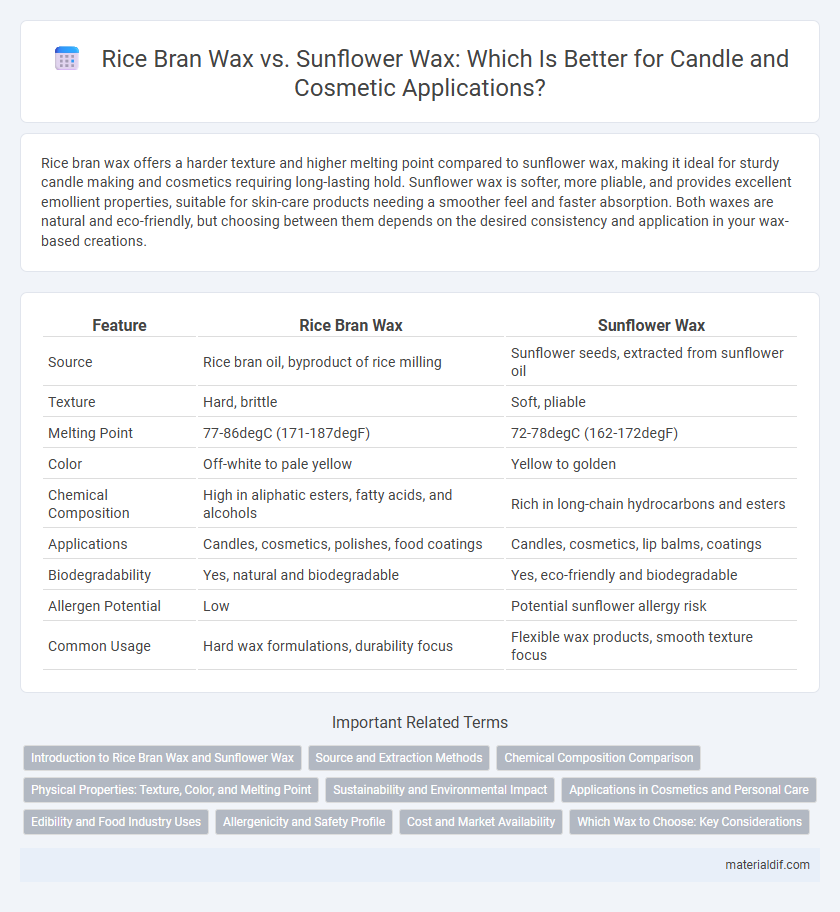Rice bran wax offers a harder texture and higher melting point compared to sunflower wax, making it ideal for sturdy candle making and cosmetics requiring long-lasting hold. Sunflower wax is softer, more pliable, and provides excellent emollient properties, suitable for skin-care products needing a smoother feel and faster absorption. Both waxes are natural and eco-friendly, but choosing between them depends on the desired consistency and application in your wax-based creations.
Table of Comparison
| Feature | Rice Bran Wax | Sunflower Wax |
|---|---|---|
| Source | Rice bran oil, byproduct of rice milling | Sunflower seeds, extracted from sunflower oil |
| Texture | Hard, brittle | Soft, pliable |
| Melting Point | 77-86degC (171-187degF) | 72-78degC (162-172degF) |
| Color | Off-white to pale yellow | Yellow to golden |
| Chemical Composition | High in aliphatic esters, fatty acids, and alcohols | Rich in long-chain hydrocarbons and esters |
| Applications | Candles, cosmetics, polishes, food coatings | Candles, cosmetics, lip balms, coatings |
| Biodegradability | Yes, natural and biodegradable | Yes, eco-friendly and biodegradable |
| Allergen Potential | Low | Potential sunflower allergy risk |
| Common Usage | Hard wax formulations, durability focus | Flexible wax products, smooth texture focus |
Introduction to Rice Bran Wax and Sunflower Wax
Rice bran wax, derived from the outer layer of rice grains, offers excellent emollient properties and high melting points, making it ideal for cosmetics and skincare formulations. Sunflower wax, extracted from sunflower seed oil, provides a natural, hypoallergenic alternative with good texture and moisture retention, commonly used in lip balms and creams. Both waxes serve as sustainable, plant-based thickeners and stabilizers in personal care products, emphasizing eco-friendly ingredient choices.
Source and Extraction Methods
Rice bran wax is derived from the outer layer of rice grains through a solvent extraction process, yielding a natural wax rich in fatty acids and hydrocarbons. Sunflower wax is obtained by dewaxing sunflower oil through crystallization and filtration, resulting in a pure, eco-friendly wax high in esters and saturated fatty alcohols. Both waxes serve as sustainable alternatives in cosmetics, with rice bran wax offering a higher melting point and sunflower wax providing better emollient properties.
Chemical Composition Comparison
Rice bran wax primarily consists of esters of aliphatic acids and higher alcohols, predominantly comprising palmitic acid esters. Sunflower wax is mainly composed of long-chain fatty acid esters, such as behenic and lignoceric acids. The higher content of saturated esters in rice bran wax contributes to its harder texture, while sunflower wax contains more unsaturated components, affecting its melting point and flexibility.
Physical Properties: Texture, Color, and Melting Point
Rice bran wax features a firm texture with a pale yellow color and a melting point ranging between 77-86degC, making it suitable for high-temperature applications. Sunflower wax has a softer consistency, creamy white to light yellow color, and a lower melting point of about 70-78degC, allowing for easier blending in cosmetic formulations. Both waxes offer distinct physical properties that influence their performance in skincare and candle-making products.
Sustainability and Environmental Impact
Rice bran wax is derived from the hard outer layer of rice grains, making it a sustainable byproduct of rice production that reduces agricultural waste and promotes resource efficiency. Sunflower wax is extracted from sunflower seed husks, a renewable and biodegradable resource known for its lower carbon footprint and minimal environmental impact. Both waxes support eco-friendly practices, but rice bran wax offers additional sustainability benefits through its use of an otherwise discarded material, contributing to a circular economy in agriculture.
Applications in Cosmetics and Personal Care
Rice bran wax offers excellent emollient properties and stability, making it ideal for lip balms, creams, and lotions in cosmetics and personal care products. Sunflower wax is valued for its light texture and high melting point, commonly used in lipsticks, deodorants, and hair care formulations. Both waxes provide natural alternatives to petrochemical waxes, enhancing product texture and moisturizing benefits in skincare and beauty applications.
Edibility and Food Industry Uses
Rice bran wax, derived from the outer layer of rice grains, is edible and commonly used as a coating agent in the food industry to enhance texture and preserve freshness. Sunflower wax, obtained from sunflower seed petals, is also edible and valued for its natural origin and hypoallergenic properties, often utilized in edible films and confectionery coatings. Both waxes serve as natural alternatives to synthetic coatings, offering food-grade safety and functional benefits in preserving and improving the quality of food products.
Allergenicity and Safety Profile
Rice bran wax, derived from the bran oil of rice, exhibits a low allergenicity profile, making it suitable for sensitive skin applications and cosmetic formulations. Sunflower wax, extracted from sunflower seed oil, is also recognized for its hypoallergenic properties but may pose minimal risks to individuals with seed allergies. Both waxes maintain a favorable safety profile, but rice bran wax is often preferred in products marketed towards allergy-conscious consumers due to its lower incidence of allergic reactions.
Cost and Market Availability
Rice Bran Wax is generally more cost-effective than Sunflower Wax due to its abundant production as a byproduct of rice milling, making it widely available in Asian markets. Sunflower Wax, while often priced higher because of its extraction from sunflower seeds, enjoys strong demand in Europe and North America, where its natural, hypoallergenic properties are especially valued. Market availability for Rice Bran Wax tends to be broader globally, whereas Sunflower Wax availability can fluctuate seasonally based on sunflower crop yields.
Which Wax to Choose: Key Considerations
Rice bran wax offers a high melting point and excellent emollient properties, making it ideal for thicker formulations like balms and creams. Sunflower wax, derived from sunflower seeds, provides a lighter texture and better spreadability, suitable for lotions and softer products. Consider the desired consistency, melting point, and skin feel when choosing between these natural waxes for cosmetic or candle-making applications.
Rice Bran Wax vs Sunflower Wax Infographic

 materialdif.com
materialdif.com